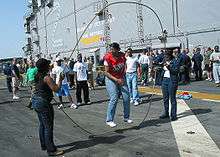Double Dutch (jump rope)

Double Dutch is a game in which two long jump ropes turning in opposite directions are jumped by one or more players jumping simultaneously. It is popular worldwide.[1] Competitions in double Dutch range from block parties to the world level. During the spring of 2009, double Dutch became a varsity sport in New York City public high schools.[2] It has been fancifully debated whether double Dutch came over with the first Dutch settlers or appeared in the first half of the 1900s.[1]
Technique

Playing double Dutch involves at least three people: one or more jumping, and two turning the ropes. A jumper usually performs tricks that may involve gymnastics or breakdance, and may also incorporate fancy foot movements.
Double Dutch in the media
The 1981 single "Double Dutch Bus" by Frankie Smith features African American girls playing this game in the video clip of the song.
The 1983 single by Malcolm McLaren, "Double Dutch" features a number of New York City troupes. It is taken from his debut album Duck Rock.
The 1991 single by American hip-hop duo DJ Jazzy Jeff & The Fresh Prince, "Summertime" mentions "girls playing Double Dutch". It is taken from their fourth studio album, Homebase.
Doubletime, a documentary from Discovery Films, tells the story of the historic meet-up of rope skipping and double Dutch. The film follows two top teams; the Bouncing Bulldogs and the Double Dutch Forces, as they train to compete against each other for the very first time. The competition takes place at the Apollo Theater in Harlem.
In 2005, Elizabeth Verity, aka Double Dutch Girl, began jumping her way around the U.S. raising money for the United States military. Double Dutch Girl jumped rope in St. Louis, Chicago, Washington and several small towns throughout the Midwest. Ultimately, her goal is to jump rope in all 50 states.[3]
The 2007 Disney Channel original movie Jump In! features double Dutch as the central element of its plot. Jump In! features the Dutch Dragons, based on a real double Dutch team from 1997 in Harlem. Jump!,[4] an award-winning documentary following five teams from around the United States who push their physical and psychological limits in pursuit of winning the World Rope Skipping Championship, also premiered at the Los Angeles Film Festival in 2007
In 2010, Saltare was on season 5 of America's Best Dance Crew and the group featured single rope and double Dutch in their dance routines.[5][6]
A 2010 PBS documentary, New York Street Games, includes Whoopi Goldberg describing double Dutch.[7]
On January 15, 2007, in honor of Martin Luther King, Jr. Day, the Google homepage featured a double Dutch logo with black children playing with white children, emblematic of the realization of Martin Luther King, Jr's "I Have A Dream" speech in 1963.[8]
The game is featured in the Wee Sing production "Grandpa's Magical Toys".
The music video to the 2010 track by DJ Fresh, Gold Dust, centres on double Dutch skipping. In the music video of Yves Larock hit 2007 track "Rise Up", double Dutch is the theme used.
In his dual title role of the 2011 movie Jack & Jill, Adam Sandler gives a demonstration of double Dutch jump rope on board the cruise liner.
There is a double Dutch jump roping competition in the 2015 film War Room.[9]
Competitive Double Dutch
The National Double Dutch League holds yearly camps and a Holiday Classic, in which teams from all over the world compete. Double Dutch is also an integral part of USA Jump Rope Tournaments as well as the AAU Junior Olympic Games and the World Jump Rope Federation's worldwide annual competitions.
The World Jump Rope Championships were held in July, 2012, at George Washington University, in Washington D.C.[10][11]
Double Dutch competitions are categorized as compulsory, freestyle, and speed rope.
Notes
- 1 2 http://online.wsj.com/article/SB119448972267686072.html?mod=googlenews_wsj
- ↑ Hu, Winnie. Double Dutch Gets Status in the Schools, New York Times, July 31, 2008
- ↑
- ↑
- ↑ "Saltare". USA Jump Rope.
- ↑ Goodtree, Hal. "Morrisville's Saltare on America's Best Dance Crew". carycitizen.com.
- ↑ Hector Elizondo (Narrator); Matt Levy (Director). New York Street Games (Motion picture). New York City. Retrieved 14 Nov 2011.
- ↑ Google MLK Day logo
- ↑ A Spiritual Battle in the War Room
- ↑ Kelly, Brian. "Bainbridge jumpers win gold medals at world championship". bainbridgereview.com.
- ↑ Owens, Dave. "World Jump Rope Championships Unlike Jumping Rope In Your Backyard". WUSA 9.
References
- Veronica Chambers, Double Dutch, ISBN 978-0-7868-0512-9, Jump At The Sun; 1 edition (October 14, 2002)
- Kyra D. Gaunt, The Games Black Girls Play: Learning the Ropes from Double-Dutch to Hip-hop, ISBN 0-8147-3120-1, Published 2006 NYU Press
External links
- Doubletime, Discovery Channel (documentary)
- National Double Dutch League
- USA Jump Rope website
- British Rope Skipping Association
- Jump! documentary feature film